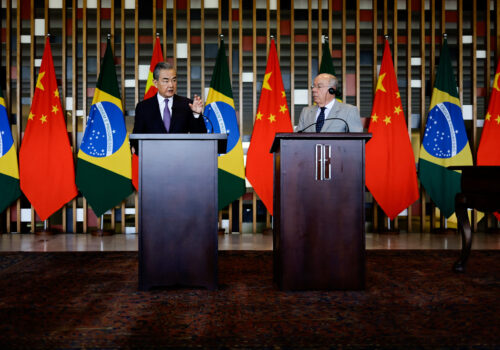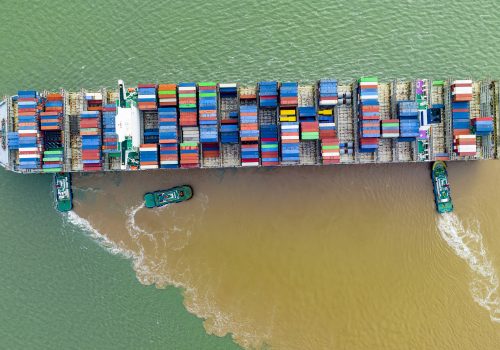“Connector economies” and the fractured state of foreign direct investment
Heightened geopolitical rivalry has led to geoeconomic fragmentation—a development that has been documented by international organizations such as the International Monetary Fund (IMF), World Trade Organization (WTO), and United Nations Conference on Trade and Development (UNCTAD). Most attention has been focused on the fragmentation of world trade. But fragmentation can be observed in the flow of foreign direct investment (FDI) as well. And, like trade, the picture is nuanced: Global FDI flow has fallen as a share of GDP, but a handful of countries have seen an influx.
Geopolitics is rearranging FDI
Geopolitical tension and geoeconomic fragmentation have elevated uncertainty which, together with slow growth, have significantly cut back global FDI flows as a share of economic activity—from 3.3 percent of global GDP in the 2000s to only 1.3 percent in the past five years. In absolute terms, FDI has increased modestly: In 2023, global FDI flows reached an estimated $1.3 trillion or 3 percent more than in 2022.
The slowdown in FDI has disproportionately affected emerging-market and developing countries (EMDCs). FDI flows to developed countries increased by 29 percent, to $524 billion. But flows to developing countries decreased by 9 percent to $841 billion.
These shifts are not driven merely by economic factors: Detailed analysis of almost 300,000 instances of greenfield investment projects from 2003 to 2022 by the Center for Economic Policy Research (CEPR) shows an economically significant role of geopolitical alignment in driving the country allocation of bilateral investments. The friendshoring and nearshoring approaches used to derisk from economic dependencies have significantly affected the pattern of FDI flows of the two main protagonists—the United States and China.
The United States and China
Between 2019 and 2023, FDI flows from the United States to China fell from a 5.2 percent share of total FDI to 1.8 percent—or a drop of 3.4 percentage points of total US FDI outflow. By contrast, shares of US FDI to more geopolitically aligned countries increased—for example, plus four percentage points to India (from 7.6 percent to 11.6 percent); plus 3.4 percentage points to the UAE; plus 2.2 percentage points to Mexico; and roughly plus one percentage point to several Southeast Asian countries such as Malaysia, the Philippines, and Vietnam.
Due largely to the sharp drop of FDI from the United States, total FDI flow to China has declined significantly—from an annual average of $235 billion in the ten years 2011-2020 to $344 billion in 2021, $180 billion in 2022, and only an estimated $15 billion in 2023—mainly due to heightened geopolitical tension and slow growth in China.
Outbound FDI from China has also diminished from a peak of $196 billion or 1.9 percent of GDP in 2016 to $146 billion or 0.8 percent of GDP in 2022. Traditionally, China’s FDI outflow has favored developed countries in North America and Europe (accounting for more than 60 percent of the total) followed by Asia. In recent years Asia’s share has risen. For example, the share of China in ASEAN FDI inflow was 3 percent (8 percent including Hong Kong) in 2016 rising to 8 percent (13 percent including Hong Kong) in 2021. (That is still lower than the 23 percent share of the United States, the biggest investor in the region.) It is important to keep in mind that developing countries have received the lion’s share of China’s international construction projects financed by debt, now totaling $815 billion, mainly through participating in the Belt and Road Initiative (BRI).
The “connector” economies
FDI, especially from competing countries like the United States, Europe and China, have tended to flow to not only geopolitically close countries satisfying friendshoring and nearshoring criteria, but also—especially in the case of Western companies—to those having a minimum necessary political stability, legal, and regulatory environment and manufacturing capabilities including suitable labor supply. As a result, only a dozen or so countries have experienced increased FDI flows from both the United States and China.
In particular, five countries (Vietnam, Indonesia, Mexico, Poland, and Morocco) have been dubbed “economic connectors” by Bloomberg Economics. These countries have combined appropriately calibrated foreign policies and sufficiently developed economic capabilities to navigate geopolitical rivalry and benefit from geoeconomic fragmentation—which has driven the reconfiguration of global supply chains. Basically, they have been able to leverage the friendshoring and nearshoring approaches of the United States and China to attract more greenfield investment from both. They have also increased their exports to the United States (or to the EU in the case of Poland) and their imports (mostly of intermediate goods) from China.
The experiences of the five economic connectors show that there is a pathway for developing countries to navigate geopolitical tension while developing their economies. However, it requires those countries to be able to compete with fellow developing countries to attract trade and investment from either or both China and the United States (and other developed countries). Many may lack the capacity to do so, especially low-income countries and those without natural resources or basic manufacturing capabilities.
In short, the geopolitically driven fragmentation of the global economy has several dimensions: division between developed and developing countries; according to geopolitical alignment; and among developing countries themselves based on their abilities to compete for trade and investment in the reconfiguration of global supply chains. This has increased the complexity of the fragmentation process, probably making it more difficult to measure as well as more costly to the global economy than so far expected. Unfortunately, low-income countries will likely experience the worst outcomes.
Hung Tran is a nonresident senior fellow at the Atlantic Council’s GeoEconomics Center, a former executive managing director at the Institute of International Finance and former deputy director at the International Monetary Fund

At the intersection of economics, finance, and foreign policy, the GeoEconomics Center is a translation hub with the goal of helping shape a better global economic future.
Further reading
Mon, Feb 12, 2024
Don’t let geopolitics undermine Latin America’s hard-won free markets
Atlantic Council Strategy Paper Series By
The United States is concerned about China’s close economic ties to Latin America and the Caribbean; however, the US response should be careful not to undermine longstanding market norms and popular trade liberalization policies
Mon, Sep 18, 2023
Scaling up the transatlantic partnership from security to prosperity: Economic resilience in Eastern Europe
The Freedom and Prosperity Equation By
Achieving long-term prosperity and stability in Eastern and Central Europe requires strategic engagement by Western allies. Economic resilience is crucial and requires three overlapping lines of effort: increasing European integration; transitioning to a new economic model; and engaging all societal actors in the pursuit of sustainable and shared prosperity.
Tue, Jul 25, 2023
Is ‘friendshoring’ really working?
New Atlanticist By
The Biden administration has identified around 2,400 critical goods and materials that fall under its efforts to move supply chains out of China. Check out what the data reveal so far.
Image: Lodz, Poland, July 27, 2013. Construction work at the Lodz Fabryczna Station.


